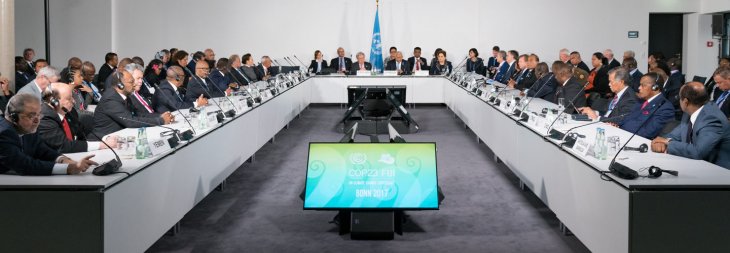
A meeting, hosted by the COP23 president, with heads of state and government, the Secretary-General of the UN, and the Executive Secretary of UNFCCC. PHOTO: James Dowson/UNFCCC/Flickr.
A measured dose of optimism and small steps towards implementing the Paris Agreement were overall good outcomes for this year’s climate conference held from November 6-17, known officially as the 23rd Convention of the Parties (COP23) to the UN Framework Convention on Climate Change.
Despite global security concerns, there was little of the rhetoric from earlier COPs where the security implications of climate change dominated discussions on the urgent need for action. Instead, there were many—albeit tentative—examples of cooperation, including the Talanoa Dialogue, America’s Pledge, climate risk insurance initiatives, and new funding announcements. Positive developments aside, COP23 closed with substantial uncertainty for finalizing the implementation rules for the Paris Agreement prior to COP24 and serious questions remain as to whether actions will be taken towards limiting the global temperature increase to 2oC above pre-industrial levels, let alone the more ambitious 1.5oC goal forwarded in the Paris Agreement.
The convention opened on a lower note in light of the US administration’s intention to pull out of the Paris Agreement; the present pledges in the Nationally Determined Contribution (NDC) only meeting roughly a third of the emission reductions needed to achieve a 2oC temperature goal; and signals that credible commitments from developed countries were being undermined by the inability to bring the Doha Amendment to the Kyoto Protocol into force—leaving a gap in mechanisms for emission reductions and climate actions to 2020. At the same time, the need for action was underscored by severe weather in 2017 and the reaffirmation of the current and future risks from climate change in the US National Climate Assessment’s report on the state of the climate.
The next round of NDCs due in 2020 will perhaps be the true test of the effectiveness of climate diplomacy.
With this backdrop, Fijian Prime Minister Frank Bainimarama kicked off the COP by highlighting the need for diplomacy and cooperation. Citing the existential risks, especially for small island developing states like Fiji, the prime minister launched a facilitative dialogue process, naming it the “Talanoa” dialogue—a traditional form of storytelling from Fiji and the Pacific that is used to build empathy and make wise decisions for the collective good. These efforts were underscored by the America’s Pledge, led by California Governor Jerry Brown and former New York City mayor Michael Bloomberg, and the We Are Still In network. Under the Twitter hashtag #WeAreStillIn, high-profile events held in a separate tent adjacent to the formal UN Bonn meeting spaces were designed to reassure the international community that subnational actors were still able to deliver on US contributions under the Paris Agreement.
The conference also saw important announcements for “loss and damage” and finance. These two elements were central to securing the cooperation of developing countries for the Paris Agreement and thus, making them meaningful is critical to ensuring the agreement’s implementation. Loss and damage represents a major concern for developing countries related to the ability to recover quickly from both sudden and slow onset climate impacts. Emphasizing risk sharing through insurance, new partnerships were launched that improve the affordability and coverage of insurance and financial assistance through InsuResilience and the Fiji clearinghouse for risk transfer. However, developing countries have expressed substantial concern that the work plan is too narrowly focused on insurance at the expense of other financial assistance and capacity building. Separately, other major announcements were made to support climate resilient development, notably the Adaptation Fund, although efforts remain to reorient more existing funding mechanisms to the Paris Agreement.
Finally, implementation of the Paris Agreement has been formally linked to the SDGs through goal 13 on climate action. Recognizing that not all of the 17 SDGs can be achieved in isolation, there are major academic and policy efforts underway to identify synergies and trade-offs. The climate-conflict relationship is also addressed through SDG16, which seeks to promote peaceful and inclusive societies, the provision of access to justice, and effective, accountable institutions at all levels. While there is little evidence for direct paths from climate change to conflict, it is clearer that achieving goal 16 by reducing the known drivers of conflict and enhancing post-conflict peacebuilding will support stronger governance that can enact effective climate policies.
State parties now have until COP24 to continue working on the rules of the Paris Agreement. With Nicaragua and Syria ratifying the Paris Agreement, the US is likely to remain isolated in its direct opposition. However, the next round of NDCs due in 2020 will perhaps be the true test of the effectiveness of climate diplomacy. With the pledges in the current set of NDCs insufficient for attaining the end of century target of 2oC, there is already the need for steep near-term reductions. There will also be additional pressure as the Intergovernmental Panel on Climate Change (IPCC) will be releasing its special report on the 1.5oC temperature target in 2018. Whether the Paris Agreement’s country-driven approach to producing voluntary pledges can achieve these targets remains to be seen.
This blog post was originally published on the Global Observatory.
Leave a Reply